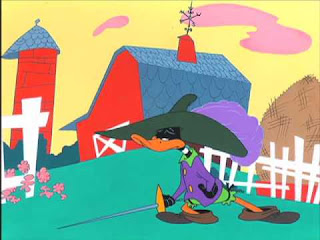Duck Amuck: http://www.dailymotion.com/video/x2j6pt1
They are almost opposites when considering the target audiences because of the content they show. Duck Amuck is comedic and deconstructive as it's obvious Daffy Duck and his scenery is being manipulated by an illustrator. Visually it's pleasing and appropriate for young audiences however adults would be able to perceive and fully understand what is happening to Daffy Duck. A Short Vision is very apocalyptic, creates social paranoia and is paradiamatic as it creates it's own paradigm for how the world ends. With the explicitly morbid imagery shown this would not be appropriate to show to young audiences, but adults who are comfortable with such images would be fine depending on how much of a psychological effect this may give. You can also hear a narrator telling us what is happening.
A Short Vision: https://www.youtube.com/watch?v=BkhNED3-mnI
Duck Amuck makes it clear Daffy is being animated as he is being effected by a external being drawing, painting and erasing Daffy and the sceneries. Even two Daffy's from different frames have a confrontation. Daffy even says this is an animated cartoon. It ends with showing that Bugs Bunny is the one effecting Daffy, an animation drawn by an animation. A Short Vision shows us a mysterious object in the sky which keeps changing shape meaning that it cannot be precieved what it is and animals (predators and prey) who see it disregard what they are doing and hide in fear. It gives you the idea at first that anything that sees the object will die once it explodes making you think the people sleeping are fine. But shorty afterwards the narrator says that everything else dies showing it as it happens and the whole world is destroyed creating a false sense of security, that nothing was safe. This also creates paranoia that doom may come without us knowing before it's too late and no matter what nothing is spared.
I would say Duck Amuck is simply a cartoony 2D drawn animation showing a lot of movement from the character Daffy Duck and very colourful. Compared to A Short Vision which shows detailed painted imagery but not an a lot of movement and contains lots of transitions/transformations.
Sound effects are appropriate to each animation. Duck Amuck as a variety of sound effects to go well with the multitude scenery shown, to add humour and to emphasize certain actions done by Daffy. It doesn't sound serious considering its target audience, unlike A Short Vision which doesn't have such happy tones. In A Short Vision all sound effects are done by orchestra giving it an eerie and mysterious feeling of what is about to happen. They both share non-diegetic sounds.
They both really have no deep meaning behind them rather then to tell their stories to the audience. The only reason behind Duck Amuck's purpose is to provide comedic entertainment for young to adult audiences and provide awareness to how these types of animation are made, drawn/painted illustrations. For A Short Vision the only reason behind its purpose is to scare or cause paranoia about the unpredictable destruction of the world and how it the creator of this animation perceives how it will end.

